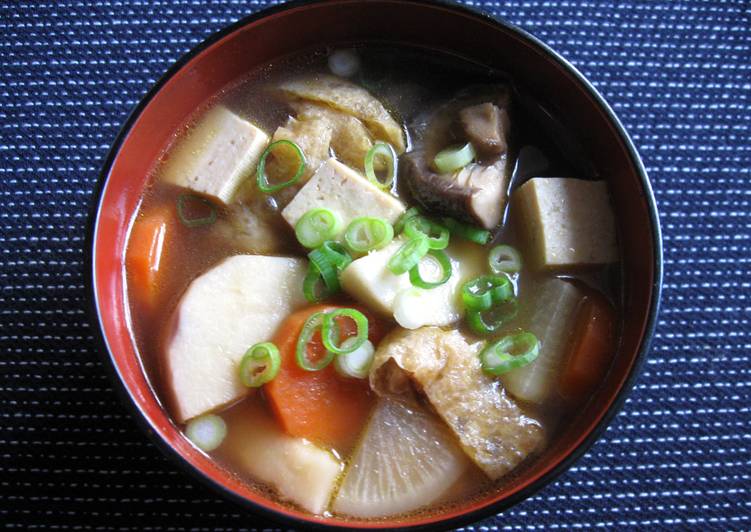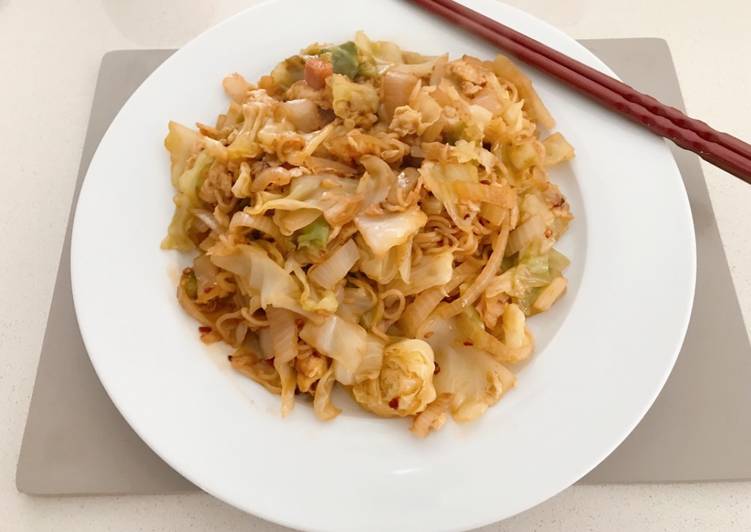
Hello everybody, it’s me again, Dan, welcome to our recipe page. Today, I’m gonna show you how to make a distinctive dish, monk’s vegan soup ‘kenchin-jiru’. One of my favorites food recipes. This time, I’m gonna make it a little bit tasty. This is gonna smell and look delicious.
Monk’s Vegan Soup ‘Kenchin-jiru’ is one of the most well liked of current trending foods on earth. It is simple, it is fast, it tastes yummy. It is appreciated by millions daily. They’re nice and they look wonderful. Monk’s Vegan Soup ‘Kenchin-jiru’ is something that I’ve loved my whole life.
This soup is called 'Kenchin-jiru' in Japan. It is originally a Buddhist dish and vegan. Vegetable base stock, such as Shiitake Mushroom OR Kombu (Kelp), is used for this soup.
To get started with this particular recipe, we must prepare a few components. You can cook monk’s vegan soup ‘kenchin-jiru’ using 16 ingredients and 8 steps. Here is how you cook it.
The ingredients needed to make Monk’s Vegan Soup ‘Kenchin-jiru’:
- Take 1-2 teaspoons Sesame Oil
- Make ready 1/2 Carrot
- Prepare 5 cm Daikon (White Radish)
- Prepare 4-5 Satoimo (small Taros) *OR 1 large Potato
- Take 10 cm Gobo (Burdock Root) *optional
- Make ready 1 pinch Salt
- Take 4 tablespoons Soy Sauce
- Get Ground Chilli OR finely ground White Pepper *optional
- Prepare 200 g Tofu *medium firm type such as ‘Momen’
- Take 1 sheet Abura-age (Fried Thin Tofu)
- Take 3 & 1/2 cups Water
- Take 1 Spring Onion *finely shopped
- Make ready 10 cm Kombu (Kelp)
- Make ready <Stock>
- Prepare 4-5 Dried Shiitake
- Get *Note: You can use 1 heaped teaspoon Dashi Powder instead
This savory vegan dashi is loaded with. Kenchinjiru is a flavorful vegan soup created originally as a Buddhist temple cuisine (精進料理) with root vegetables and What is Kenchinjiru? Japanese Vegetable Soup (Kenchinjiru) is quite filling but has very low calories. Japanese Vegetable Soup (Kenchinjiru) was originally a Buddhist dish that is vegetarian.
Instructions to make Monk’s Vegan Soup ‘Kenchin-jiru’:
- Prepare the stock first. Place cold Water in a bowl, add cleaned Kombu (Kelp) and Dried Shiitake, and soak for at least 1-2 hours. Softened Shiitake can be cut into small pieces and added to the soup later.
- *Note: Do not add the softened Kombu to the soup. Kombu will get slimy and unpleasant flavour will come out. Use it for something else.
- Cut all Vegetables and Tofu into small pieces that are easy to eat. Finely cut Spring Onion for topping.
- Heat Sesame Oil in a large saucepan or pot, stir-fry Vegetables for a few minutes. Add 1 pinch Salt to season.
- Add 3 cups Kombu (Kelp) and Shiitake stock. (*Avoid the dirt and settlings.) Bring to the simmer and cook for 10 minutes. Season with Soy Sauce and cook until all vegetables are soft.
- *Note: I add 1 pinch Ground Chilli OR White Pepper for a hint of spiciness. This is totally untraditional, but I like it.
- When Vegetables are soft, add Abura-age (Fried Thin Tofu) and Tofu, and bring back to the boil. Then it’s done!
- Sprinkle with finely chopped Spring Onion and enjoy.
Root vegetables and tofu are sautéed and cooked in flavoured dashi broth. Enjoy this soothing soup inspired by an old recipe from a famous Japanese Buddhist temple. Kenchin jiru (けんちん汁, 巻繊汁 kenchinjiru), also spelled kenchin-jiru, and sometimes referred to simply as kenchin, is a Japanese vegetable soup prepared using root vegetables and tofu. It is a popular dish in Japan and is prepared in various manners using myriad ingredients. Since kenchinjiru is a shojin ryouri or temple cuisine dish, the basic version given here is vegan.
So that is going to wrap this up with this exceptional food monk’s vegan soup ‘kenchin-jiru’ recipe. Thanks so much for reading. I’m confident that you can make this at home. There is gonna be interesting food in home recipes coming up. Don’t forget to save this page in your browser, and share it to your family, friends and colleague. Thank you for reading. Go on get cooking!


